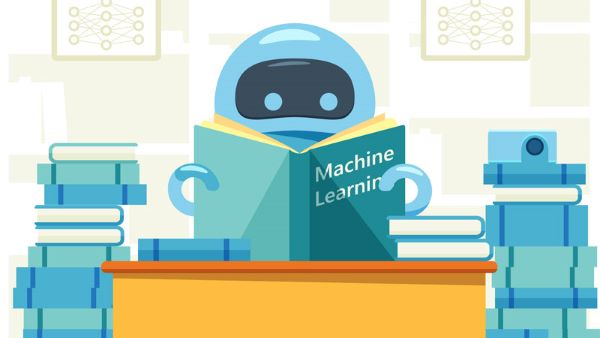[Can't Miss] How Does AI Training Work?
The answer to how AI training works is pretty simple. Just like humans need to get lots of training and practice before excelling at something new, AI needs to get trained on tons and tons of data before it is ready to come up with an accurate outcome.
In simple words, AI training is defined as a machine learning process where datasets are put as input into the machine learning models and parameters are changed within the model to expect an accurate outcome for any similar type of data. It is a procedure of training an AI system to perceive, interpret and learn from the information or data provided to it. This article has a detailed explanation of AI, its training and the branches it has.
1. How does AI training Work?
AI training is not a simple task to perform. It carries a series of steps that need to be done before making a model completely trained. These trained models can then be used to make accurate predictions and outcomes for the data provided to them. Let us first discuss the fundamental steps that make the base to train AI.

- The first step is the training, where tons of data is provided to the model of AI and then parameters are changed in order for the model to make predictions on the information provided. In these predictions, the changes are made by the scientist according to the prediction accuracy score.
- The second major step is the validation. Here, a new dataset is given to the trained AI model and they analyze the results with their specific questions.
- The third primary step is testing. The testing may be carried out by providing a novel dataset that does not have any targets or tags. This dataset helps in learning for the AI model. If the outputs are accurate, it means that the AI has passed the test.
2. Five Major Sub-fields of AI
AI is a vast field and it is not at all specified to just one subject. It has numerous sub-fields as well that themselves have further sub-fields. Let’s explore sub-fields:
Machine learning:
Machine learning is a combination of techniques and algorithms that make machines/computers capable enough to learn something and make predictions in order to make decisions. The learning is done through AI training and the process includes several steps which will be discussed further in this article.
Natural Language Processing:
This field of AI is totally dedicated towards the interaction of Humans and computers which includes the understanding of language, the generation of language, machine
Computer Vision:
Computer Vision is a field of AI that is totally focused towards the understanding of visual information from the outer world and interpreting it. Such fields may be included in object detection, facial recognition, scene understanding, image generation, and image detection.
Robotics:
Robotics is focused on physical interaction and when AI integrates with it, it is easier to interact and communicate with humans. It is mainly used in robot control, autonomous robots, human robot interaction, and motion planning.
Expert Systems:
These systems are primarily targeted towards the decision-making abilities of computers.
They are made on the specific knowledge base, reasoning and techniques in order to solve complex problems and give expert advice.
3. The Process of AI Training
The process of AI training is a combination of multiple steps that make a model trained. The following are the generic steps that can be used for any AI training data.
- Step 1.Data collection:
- The first and most crucial step of AI training is the collection of data related to the task that is given. It could be books, websites, articles, and more.
- Step 2.Data Preprocessing:
- The second step in AI training is to make the available data clean and organized. This can include deleting irrelevant information, deleting duplication or converting to data in a suitable format that can be used by the model
- Step 3.Model Architecture Design:
- In the third step, the architecture of the AI model is designed. This can be a neural network.
- Step 4.Initialization:
- After the model architecture has been designed, the initialization occurs. This includes the parameters that are randomly initialized at first. Through these parameters, the model will be learning and adjusting its parameters.
- Step 5.Training Loop:
- After initialization, the training loops get into the process steps. Here, the following processes include:
- 1.Forward Pass:
Within the iterations, the preprocessed data is fed into the model. This iteration is carried out in layers through a forward pass while making predictions. - 2.Loss Calculation:
In this step, the actual expected data and the model prediction are compared and there is a loss function that is responsible for measuring the difference between the truth and the prediction. - 3.Back Propagation:
In this step, the adjustments of the parameters of models are made in which the loss is reduced.
- 1.Forward Pass:
- Step 6.Gradient Descent:
- This is an optimization technique in which the parameters are adjusted that are based on the calculated gradients during back propagation. This makes it possible for the model to make better predictions once the loss is minimized.
- Step 7.Iterations:
- In this step, the previous two steps are repeated on the data that is available for training.
- Step 8.Validation and testing:
- Validation and testing are performed on a separate dataset in order to make sure that the model does not overfit (performing and predicting well on the training data and poorly on the new data which is provided to it The testing is also done on a whole new dataset to evaluate how well the generalization of the model is.
- Step 9.Fine Tuning:
- Fine-tuning is done after looking at the results of the testing and the validation, Here, the hyperparameters and the model’s architecture are adjusted in order to improve the performance of the model.
- Step 10.Deployment
- In this part of the process, the model is finally trained satisfactorily on the testing and validation data. The model can then be deployed to be used in the real world. Integration of models into apps, web apps, websites and other systems to provide assistance through AI is a practice that must be performed.
4. Seven Branches of Artificial Intelligence
Artificial intelligence is not just limited to a single subject. It has many branches and there are several areas that are covered by AI. Let's have a look at a few of them.
1. Computer Vision
As explained above, this branch of AI is related to developing techniques that can assist machines and computers to understand and interpret videos and images. When machine learning models are applied to images and videos, the computers are able to detect or identify the components in an image such as faces, people, animals, and more. When enough data is fed into the model, the computer is able to deeply understand the differences between the images.
Computer vision is possible through the convolution neural network which works along with the machine learning model to break the images into small pixels and tags and labels are given to it. Labels are used in order to do the convolutions which is an operation of mathematics to make predictions.
The application of computer vision may include object tracking, facial recognition and image classification.
2. Fuzzy Logic
Fuzzy logic is purely based on the human way of decision making where conclusions break down into the possibilities being given the value of “yes” and “no”. It basically measures the degree to of the hypothesis is correct.
This is majorly used when there is an uncertain topic. In simple words, to solve issues, tat can be either true or false. They are comprised of four parts. The first one is rule-based which mentions if-then conditions. The second one is Fuzzification which helps in converting the provided input. The third one is the inference engine which compares or determines how much the rules and fuzzy inputs are matching. The fourth part is defuzzification which converts the fuzzy value of data into some actual values.
3. Expert Systems
The expert systems are made for specific and specialized programs and singular tasks. These systems are made in order to solve complex specialized issues with the capabilities of a human expert.
When discussing expert systems, they use a knowledge base in which rules are given. They also use the if-then notation, to solve complicated problems.
4. Robotics
Robotics deals with the physical devices that are programmed in order to perform complex tasks. People mostly control them with control devices but their controlling system can also be embedded into them. Robotics as a field is growing at a pretty much fast pace. Humanoid robots are becoming one of the latest developments in this digital world.
5. Machine Learning
Machine learning is a field which deals with the learning ability of machines through data and algorithms. This branch is an inseparable part of AI that is focused towards the optimizations of outputs and the results. This branch of artificial intelligence makes sure that the model learns through its past experiences and provides better and more accurate outputs in the future,
The accuracy of the output is largely dependent on the data provided to the model. The more data, the better will be the results. Machine learning is divided into 3 types:
- 1. Supervised Learning
The machine learning is done through a labelled dataset for the prediction of the outcome. - 2. Unsupervised Learning
An un-labelled dataset is used for prediction. Here, patterns are taken into consideration. - 3. Reinforcement Learning
Reinforcement learning works on trial and error. It uses feedback for the learning.
6. Deep Learning or Neural Networks
Simulated neural networks or artificial neural networks are the other names of neural networks that are primarily focused on how the human brain works, The neuron signals in the brain of the human body are the same in the case of neural networks. These consist of input layers, hidden layers and an output later. Neurons connect with the neurons and have a threshold and weight associated with them, Neural data always needs training data which makes it able to learn and offer improved accuracy.
7. NLP
Natural language processes allow machines or computers to learn, perceive, and interpret spoken words as well as text. This is only possible when deep learning, linguistics and machine learning combine. This branch allows the machine to understand the sentiments as well as the intent and full meaning of what is required by humans through the text given to it.
5. Factors that Can Affect the Development &Performance of AI System
There are multiple factors that can affect the development and performance of an AI system. Below are mentioned some of the factors:
Data Quality and Quantity: Make sure that the data you are providing to the model is diverse as well as of high quality. This may help in a better generalization of the AI system’s performance.
Algorithm Selection: The algorithm you provide will affect the results. For every problem, different algorithms can be selected.
Computational Resources: Computational resources such as GPUs and TPUs specifically affect and influence the complexity and the size of the model that can be created or developed on the system.
6. What are "Training" and "Inference" in AI?
Training and inference are two different terms. Training is the fundamental and the first phase of developing a machine learning model. In the training phase of the model, a large data is fed to the the model. While considering all variables, features and relationships, adjustments are made to the internal parameters and multiple optimization techniques. After this, the loss is minimized to make accurate predictions.
Inference can be defined as a phase of machine learning model building where the model is already deployed to show predictions and outputs which are based on the unseen and new data which is provided.
7. AI Training vs. Human Training
AI training and Human training are not at all the same. They differ greatly and the methods and the process of their training are entirely different.
Humans are conscious beings, and they are capable enough to learn something new or work on some skills by getting the education as formal education, cognitive development and practical experience. This training can then be used for multiple purposes like jobs, freelancing or opening a business.
In the case of AI, there are specific steps that need to be followed in order to predict the right outcome. The AI training includes several steps like data collection, data cleaning, designing model architecture, training, validation and testing, and fine-tuning.
8. Closing
The above article has covered the question of how AI training works. Not only that, but the topics such as the branches of AI, the process of AI training, factors that affect the development of AI models, and the differences between some of the common terminologies that are used with AI training.
AI training is not at all a simple process and it carries a series of steps that need to be performed to make a model running. Also, the field of AI is not just limited to one subject but is divided into multiple branches. The quality of data, the quantity of data, the model selection and the computation resources may affect the model results and development hugely.





Leave a Reply.